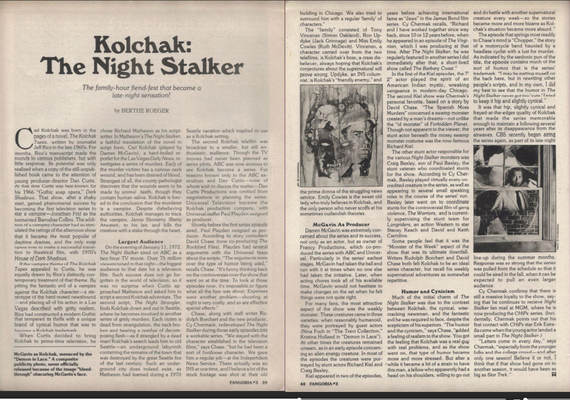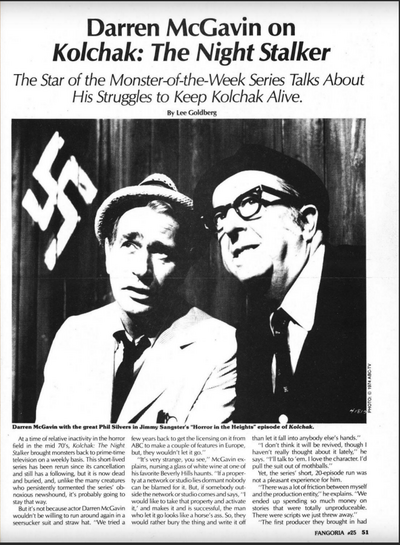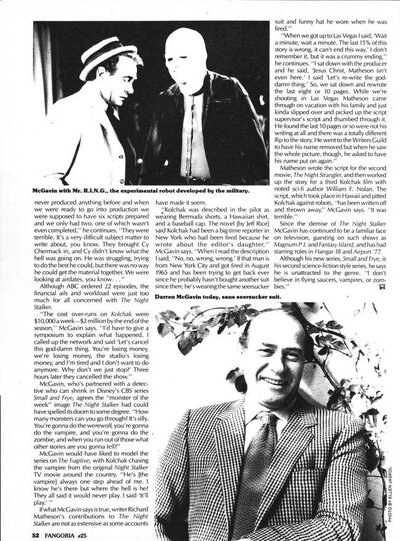JohnHopper
Senior HTF Member
- Joined
- Oct 31, 2010
- Messages
- 3,468
- Real Name
- John Hopper
Item: KOLCHAK: THE NIGHT STALKER (ABC/1974-1975)
[voice-over] “This is the story behind the most incredible series of the Seventies to ever occur at Universal studio. Now, here are the true facts. Friday night, November 12, 11 P.M., name: Kolchak, profession: reporter… almost six decades later, he reappears on a Blu-Ray edition to get by all means necessary. Take my advice, don’t wait for it, run.”
KOLCHAK: THE NIGHT STALKER • (1974-1975) (20 episodes • 50 mins • color)
The ABC series is the sequel to the two seminal telefilms created by Jeff Rice and produced by Dan Curtis. Early episodes make veiled references to the 1972 The Night Stalker (see “The Ripper”, “The Vampire”) and the 1973 The Night Strangler (see “The Ripper”). The concept of the show is based on the classical detective story framework combined with a monster of the week formula spiced with irony, social satire, wit: in other words, the main character has a dual job, part trivial newspaper reporter to pay the bills as a front and part private investigator to look for supernatural cases and therefore calls into questions the authorities, the institutions and the corporations. Unlike the previous telefilms, the character of Carl Kolchak works for the INS (Independent News Service) in Chicago and interacts with his office colleagues.
What makes this series interesting is five elements: the eccentric and anachronistic leading man wearing his personalized outfit (a seersucker suit, a straw hat aka the bird feeder, a pair of Stan Smith sneakers by Adidas) and displaying his casual and insolent Jack Lemmonesque behavior, the performances of the actors playing the leading guests or small picturesque parts, the guest police heads, the odd tone and the inspired and ambitious music scores. The added fun of the series is the art of narration (intro, outro, in between certain scenes) and to watch Carl Kolchak driving his yellow Ford Mustang (aka the Yellow Submarine) at night while the audience hears his voice-over in the tradition of the great private eyes (Cf. Mike Hammer, Philip Marlowe) and actor Darren McGavin is no stranger to this specific realm: see his previous series Mike Hammer (1958) and The Outsider (1968). Moreover, Kolchak is obviously a man from the past that is stuck in the present time (the subversive Seventies) which creates a contrast and the amusement of the audience. The folklore intrudes the urban, industrial, rationalistic and hedonistic America.
The bulk of the composers consists of two leading craftsmen: Gil Mellé and Jerry Fielding. For the record, Universal television household composer, known for Rod Serling’s Night Gallery and Columbo, and jazz musician/electronic pioneer/music concrète artist Gil Mellé is the music originator of the theme music—derived from a secondary theme of the unsold pilot The Questor Tapes—and writes the first four scores and leaves the series after a shift of the dramatical leaning and is replaced by Jerry Fielding, a major film composer involved with notorious directors (Sam Peckinpah, Michael Winner, Clint Eastwood) and also involved at Universal’s highly popular series McMillan&Wife. According to expert Jon Burlingame, Fielding writes music that is spread in seven episodes. Some of the onscreen music credits are doubtful because Universal television music supervisor Hal Mooney tracks cues from both composers and you even find double credits. Two one-shot composers also participate: Luchi de Jesus (“The Energy Eater”) and Greig McRitchie (“Horror in the Heights”)—the orchestrator of Jerry Fielding.
The majority of the stories are adaptations from third parties and two leading writers manage the body of work: Rudolph Borchert and David Chase. Only three writers participate more than once: Bill S. Ballinger (Cf. Mike Hammer), L. Ford Neale & John Huff, Arthur Rowe. One particular writer needs a special attention: British-born Jimmy Sangster who used to be one of the creative forces behind the Hammer Studios.
A troika of prolific directors (Allen Baron, Alex Grasshoff, Don Weis) set the style and dominate the season and some interesting ones pop-up once like Michael Caffey (Cf. Combat!), horror expert Gordon Hessler, Vincent McEveety (Cf. Gunsmoke). At the very end of the season, Don McDougall (Cf. Trackdown/Wanted: Dead or Alive) participates twice.
Graphic design-wise, artist Jack Cole only titles the first four episodes of the series with The Night Stalker logo.
PRODUCTION TEAM
producers: Paul Playdon, Cy Chermak
executive producer: Darren McGavin (uncredited)
story consultant: David Chase
story editors: David Chase and Rudolph Borchert (uncredited)
directors of photography: Ronald W. Browne, Alric Edens, Donald Peterman, Eduardo Ricci
After finishing his multiple task on The Magician with actor Bill Bixby, British-born producer Paul Playdon hired David Chase, managed the first two episodes (“The Ripper”, “The Zombie”), wrote one script (“The Werewolf”) and left because of Darren McGavin’s idiosyncrasy and strong commitment. He was known as a gifted writer and was also the famous script consultant on the third and fourth season of Mission: Impossible and most people remembered him for “The Mind of Stefan Miklos”. You could link the departure of Paul Playdon with the one of composer Gil Mellé but after the first four episodes.
Producer Cy Chermak was the replacement of Paul Playdon and was associated to the cop series Ironside as producer and executive producer. During his regime, composer Jerry Fielding blossomed as well as actress Ruth McDevitt.
Executive producer Darren McGavin unofficially supervised four episodes (“The Werewolf”, “Bad Medecine”, “The Energy Eater”, “Horror in the Heights”), directed composer Gil Mellé to fashion the whistling tune of the main titles sequence and was the headman on the set and the casting director in the shadow who united actors.
Story consultant David Chase was a former writer, worked on The Magician with Paul Playdon and was later connected to the private detective series The Rockford Files as a producer. Chase adapted a lot of stories from other writers on Kolchak.
Director of photography Ronald W. Browne just ending his assignment on The Magician, was very popular for Mission: Impossible from season 5 to season 7 because he altered the look of the spy series and was the main cinematographer on Kolchak but other craftsmen worked as Alric Edens (“The Zombie”), Donald Peterman (“The Ripper”), Eduardo Ricci (“They Have Been, They Are, They Will Be…”).
CAST OF CHARACTERS
regular cast: Darren McGavin (INS reporter Carl Kolchak), Simon Oakland (INS editor Tony Vincenzo).
supporting cast: Jack Grinnage (INS reporter Ron ‘uptight’ Updyke), Ruth McDevitt (INS columnist Emily Cowles alias Miss Emily), John Fiedler (coroner Gordon Spangler alias Gordy the Ghoul), Carol Ann Susi (intern and secretary Monique Marmelstein).
guest actors as police heads: Charles Aidman, Ramon Bieri, Kathie Browne—the wife of Darren McGavin—, Philip Carey, William Daniels, John Dehner, Bert Freed, James Gregory, Dwayne Hickman, Robert Karnes, Larry Linville, Ken Lynch, John Marley, William Mims, Paul Sorensen, Keenan Wynn, Robert Yuro.
Two guest actors appear twice as police heads: Ramon Bieri and Keenan Wynn in the recurring role of Captain Joe ‘Mad Dog’ Siska. Two episodes (“The Werewolf”, “The Trevi Collection”) have no guest police heads.
The strength of the show is also the colorful guest actors that add weight to the story and the majority first appears in The Outsider (1968): see Julie Adams, Fred Beir, Henry Beckman, Sorrell Booke, Tom Bosley, Eric Braeden, Henry Brandon, Frank Campanella, Corinne Camacho, Cathy Lee Crosby, Severn Darden, David Doyle, Lieux Dressler, Robert Emhardt, Erik Estrada, Sharon Farrell, Antonio Fargas, Nina Foch, Ned Glass, Julie Gregg, John Hoyt, Carolyn Jones, Henry Jones, Victor Jory, Richard Kiel, Frank Marth, Murray Matheson, Priscilla Morrill, Kathleen Nolan, J. Pat O’Malley, Lara Parker, Albert Paulsen, Andrew Prine, Barbara Rhoades, Madlyn Rhue, Pippa Scott, Joseph Sirola, Tom Skerritt, William Smith, Abraham Sofaer, Larry Storch, Michael Strong, Nita Talbot, Dick Van Patten, Katherine Woodville.
THE BLU-RAY SET
The prints are restored and look wonderful and the picture quality highlights the cinematography. It features an interview with story consultant David Chase, an interview with Dana Gould, a booklet essay by Mark Dawidziak (author of The Night Stalker Companion), twenty one audio commentaries by various experts (Mark Dawidziak, David J. Schow, Kim Newman/Barry Forshaw, Tim Lucas, Constantine Nasr, Rodney Barnes, Gary Gerani, Steve Haberman, Steve Mitchell/Cyrus Voris, Mike White/Chris Stachiw, Amanda Reyes, Michael Schlesinger), fourteen original TV spots, optional English subtitles.
[voice-over] “This is the story behind the most incredible series of the Seventies to ever occur at Universal studio. Now, here are the true facts. Friday night, November 12, 11 P.M., name: Kolchak, profession: reporter… almost six decades later, he reappears on a Blu-Ray edition to get by all means necessary. Take my advice, don’t wait for it, run.”
KOLCHAK: THE NIGHT STALKER • (1974-1975) (20 episodes • 50 mins • color)
The ABC series is the sequel to the two seminal telefilms created by Jeff Rice and produced by Dan Curtis. Early episodes make veiled references to the 1972 The Night Stalker (see “The Ripper”, “The Vampire”) and the 1973 The Night Strangler (see “The Ripper”). The concept of the show is based on the classical detective story framework combined with a monster of the week formula spiced with irony, social satire, wit: in other words, the main character has a dual job, part trivial newspaper reporter to pay the bills as a front and part private investigator to look for supernatural cases and therefore calls into questions the authorities, the institutions and the corporations. Unlike the previous telefilms, the character of Carl Kolchak works for the INS (Independent News Service) in Chicago and interacts with his office colleagues.
What makes this series interesting is five elements: the eccentric and anachronistic leading man wearing his personalized outfit (a seersucker suit, a straw hat aka the bird feeder, a pair of Stan Smith sneakers by Adidas) and displaying his casual and insolent Jack Lemmonesque behavior, the performances of the actors playing the leading guests or small picturesque parts, the guest police heads, the odd tone and the inspired and ambitious music scores. The added fun of the series is the art of narration (intro, outro, in between certain scenes) and to watch Carl Kolchak driving his yellow Ford Mustang (aka the Yellow Submarine) at night while the audience hears his voice-over in the tradition of the great private eyes (Cf. Mike Hammer, Philip Marlowe) and actor Darren McGavin is no stranger to this specific realm: see his previous series Mike Hammer (1958) and The Outsider (1968). Moreover, Kolchak is obviously a man from the past that is stuck in the present time (the subversive Seventies) which creates a contrast and the amusement of the audience. The folklore intrudes the urban, industrial, rationalistic and hedonistic America.
The bulk of the composers consists of two leading craftsmen: Gil Mellé and Jerry Fielding. For the record, Universal television household composer, known for Rod Serling’s Night Gallery and Columbo, and jazz musician/electronic pioneer/music concrète artist Gil Mellé is the music originator of the theme music—derived from a secondary theme of the unsold pilot The Questor Tapes—and writes the first four scores and leaves the series after a shift of the dramatical leaning and is replaced by Jerry Fielding, a major film composer involved with notorious directors (Sam Peckinpah, Michael Winner, Clint Eastwood) and also involved at Universal’s highly popular series McMillan&Wife. According to expert Jon Burlingame, Fielding writes music that is spread in seven episodes. Some of the onscreen music credits are doubtful because Universal television music supervisor Hal Mooney tracks cues from both composers and you even find double credits. Two one-shot composers also participate: Luchi de Jesus (“The Energy Eater”) and Greig McRitchie (“Horror in the Heights”)—the orchestrator of Jerry Fielding.
The majority of the stories are adaptations from third parties and two leading writers manage the body of work: Rudolph Borchert and David Chase. Only three writers participate more than once: Bill S. Ballinger (Cf. Mike Hammer), L. Ford Neale & John Huff, Arthur Rowe. One particular writer needs a special attention: British-born Jimmy Sangster who used to be one of the creative forces behind the Hammer Studios.
A troika of prolific directors (Allen Baron, Alex Grasshoff, Don Weis) set the style and dominate the season and some interesting ones pop-up once like Michael Caffey (Cf. Combat!), horror expert Gordon Hessler, Vincent McEveety (Cf. Gunsmoke). At the very end of the season, Don McDougall (Cf. Trackdown/Wanted: Dead or Alive) participates twice.
Graphic design-wise, artist Jack Cole only titles the first four episodes of the series with The Night Stalker logo.
PRODUCTION TEAM
producers: Paul Playdon, Cy Chermak
executive producer: Darren McGavin (uncredited)
story consultant: David Chase
story editors: David Chase and Rudolph Borchert (uncredited)
directors of photography: Ronald W. Browne, Alric Edens, Donald Peterman, Eduardo Ricci
After finishing his multiple task on The Magician with actor Bill Bixby, British-born producer Paul Playdon hired David Chase, managed the first two episodes (“The Ripper”, “The Zombie”), wrote one script (“The Werewolf”) and left because of Darren McGavin’s idiosyncrasy and strong commitment. He was known as a gifted writer and was also the famous script consultant on the third and fourth season of Mission: Impossible and most people remembered him for “The Mind of Stefan Miklos”. You could link the departure of Paul Playdon with the one of composer Gil Mellé but after the first four episodes.
Producer Cy Chermak was the replacement of Paul Playdon and was associated to the cop series Ironside as producer and executive producer. During his regime, composer Jerry Fielding blossomed as well as actress Ruth McDevitt.
Executive producer Darren McGavin unofficially supervised four episodes (“The Werewolf”, “Bad Medecine”, “The Energy Eater”, “Horror in the Heights”), directed composer Gil Mellé to fashion the whistling tune of the main titles sequence and was the headman on the set and the casting director in the shadow who united actors.
Story consultant David Chase was a former writer, worked on The Magician with Paul Playdon and was later connected to the private detective series The Rockford Files as a producer. Chase adapted a lot of stories from other writers on Kolchak.
Director of photography Ronald W. Browne just ending his assignment on The Magician, was very popular for Mission: Impossible from season 5 to season 7 because he altered the look of the spy series and was the main cinematographer on Kolchak but other craftsmen worked as Alric Edens (“The Zombie”), Donald Peterman (“The Ripper”), Eduardo Ricci (“They Have Been, They Are, They Will Be…”).
CAST OF CHARACTERS
regular cast: Darren McGavin (INS reporter Carl Kolchak), Simon Oakland (INS editor Tony Vincenzo).
supporting cast: Jack Grinnage (INS reporter Ron ‘uptight’ Updyke), Ruth McDevitt (INS columnist Emily Cowles alias Miss Emily), John Fiedler (coroner Gordon Spangler alias Gordy the Ghoul), Carol Ann Susi (intern and secretary Monique Marmelstein).
guest actors as police heads: Charles Aidman, Ramon Bieri, Kathie Browne—the wife of Darren McGavin—, Philip Carey, William Daniels, John Dehner, Bert Freed, James Gregory, Dwayne Hickman, Robert Karnes, Larry Linville, Ken Lynch, John Marley, William Mims, Paul Sorensen, Keenan Wynn, Robert Yuro.
Two guest actors appear twice as police heads: Ramon Bieri and Keenan Wynn in the recurring role of Captain Joe ‘Mad Dog’ Siska. Two episodes (“The Werewolf”, “The Trevi Collection”) have no guest police heads.
The strength of the show is also the colorful guest actors that add weight to the story and the majority first appears in The Outsider (1968): see Julie Adams, Fred Beir, Henry Beckman, Sorrell Booke, Tom Bosley, Eric Braeden, Henry Brandon, Frank Campanella, Corinne Camacho, Cathy Lee Crosby, Severn Darden, David Doyle, Lieux Dressler, Robert Emhardt, Erik Estrada, Sharon Farrell, Antonio Fargas, Nina Foch, Ned Glass, Julie Gregg, John Hoyt, Carolyn Jones, Henry Jones, Victor Jory, Richard Kiel, Frank Marth, Murray Matheson, Priscilla Morrill, Kathleen Nolan, J. Pat O’Malley, Lara Parker, Albert Paulsen, Andrew Prine, Barbara Rhoades, Madlyn Rhue, Pippa Scott, Joseph Sirola, Tom Skerritt, William Smith, Abraham Sofaer, Larry Storch, Michael Strong, Nita Talbot, Dick Van Patten, Katherine Woodville.
THE BLU-RAY SET
The prints are restored and look wonderful and the picture quality highlights the cinematography. It features an interview with story consultant David Chase, an interview with Dana Gould, a booklet essay by Mark Dawidziak (author of The Night Stalker Companion), twenty one audio commentaries by various experts (Mark Dawidziak, David J. Schow, Kim Newman/Barry Forshaw, Tim Lucas, Constantine Nasr, Rodney Barnes, Gary Gerani, Steve Haberman, Steve Mitchell/Cyrus Voris, Mike White/Chris Stachiw, Amanda Reyes, Michael Schlesinger), fourteen original TV spots, optional English subtitles.








